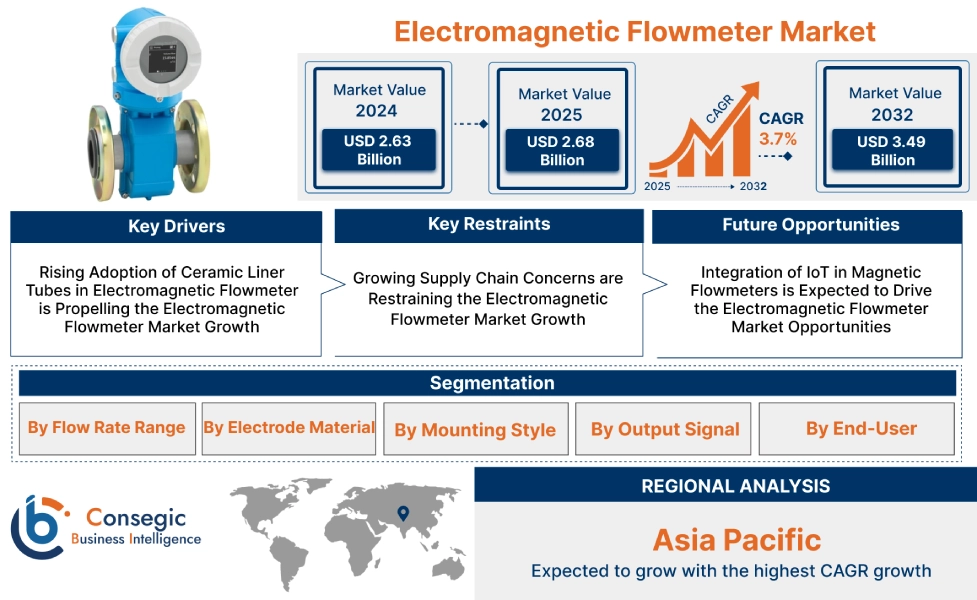Electromagnetic Flowmeter Market Size:
Electromagnetic Flowmeter Market size is estimated to reach over USD 3.49 Billion by 2032 from a value of USD 2.63 Billion in 2024 and is projected to grow by USD 2.68 Billion in 2025, growing at a CAGR of 3.7% from 2025 to 2032.
Electromagnetic Flowmeter Market Scope & Overview:
An electromagnetic flowmeter or magnetic flowmeter refers to a volumetric flowmeter that operates on Faraday's Law of Electromagnetic Induction. Magnetic flowmeters are used in several industries including chemical, water & wastewater, and oil & gas to measure the flow of a conductive liquid by inducing a voltage when the fluid passes through a magnetic field. Further, magnetic flow meters do not have any moving parts resulting in minimal maintenance. Moreover, magnetic flow meters help in producing extremely accurate measurements and can be installed easily by retrofitting into existing systems which is driving the overall market.
How is AI Impacting the Electromagnetic Flowmeter Market?
AI is playing a pivotal role in advancing the electromagnetic flowmeter market by enhancing accuracy, reliability, and operational efficiency. Traditional flowmeters often face challenges such as turbulence, variable conductivity, or mixed-fluid environments, but AI-driven analytics help compensate for these conditions by refining real-time measurements. Beyond accuracy, AI enables intelligent monitoring by detecting anomalies, identifying usage patterns, and providing predictive maintenance insights, which reduces downtime and extends device life. Furthermore, integration with IoT platforms further allows remote supervision and data-driven decision-making, making operations more transparent and efficient. As industries increasingly prioritize automation and sustainability, AI is transforming electromagnetic flowmeters into adaptive tools that support smarter industrial ecosystems.
Electromagnetic Flowmeter Market Dynamics - (DRO) :
Key Drivers:
Rising Adoption of Ceramic Liner Tubes in Electromagnetic Flowmeter is Propelling the Electromagnetic Flowmeter Market Growth
Linings are a key component of magnetic flowmeters, and their material selection can improve the service life and measurement accuracy of the flowmeters. Ceramic linings have experienced a rising adoption in the magnetic flowmeters due to several advantages including better insulating characteristics and resistance to corrosive fluids. Moreover, manufacturers today have started integrating high quality ceramic liner tubes that are thermal shock tested before using them in magnetic flowmeters.
- For instance, Yokogawa utilizes ceramic liner tubes in its ADMAG AXGmagnetic flowmeters. The ceramic liner tubes offer better durability under high temperature and high pressure without requiring a metal tube.
Hence, the growing adoption of ceramic liner tubes for accurate measurements and better durability is proliferating the electromagnetic flowmeter market size.
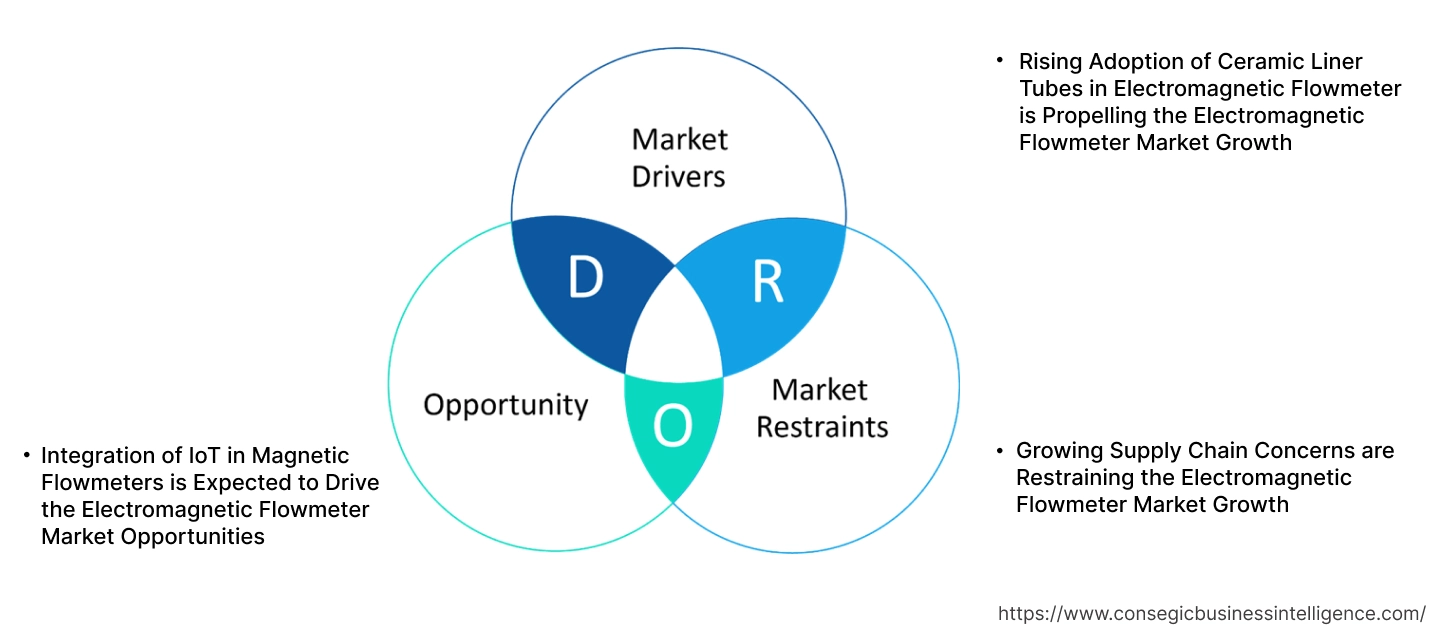
Key Restraints :
Growing Supply Chain Concerns are Restraining the Electromagnetic Flowmeter Market Growth
Stainless steel is a key material used in the production of magnetic flowmeters for various components including the electrode and the body. Stainless steel is made ‘stainless' using chromium and gets its corrosion resistance from nickel. Nickel prices in recent times have experienced fluctuations due to supply chain disruptions, which can act as a restraint to the electromagnetic flowmeter market. Additionally, several countries including India are largely dependent on nickel imports which makes the stability of nickel prices critical for manufacturers of magnetic flowmeters in these countries. Thus, the increase in supply chain issues for stainless steel and its key raw materials poses a threat to the electromagnetic flowmeter market share.
Future Opportunities :
Integration of IoT in Magnetic Flowmeters is Expected to Drive the Electromagnetic Flowmeter Market Opportunities
IoT integration for better connectivity and transmission of measurement data in magnetic flowmeters has witnessed a rising adoption. Additionally, the measurement related to the quantification of water flow can be gathered and transferred instantly with the integration of IoT devices and sensors. Moreover, IoT can also be used to analyze the performance of the flow meters and determine the possibility of the flowmeter failure in the future.
- For instance, ABB offers IoT connectivity in the new ProcessMaster and AquaMaster electromagnetic flowmeters. IoT connectivity allows the users the choice of high-speed communication options for plant-based or remote metering applications.
Thus, the rising technological advancements associated with IoT integration for better connectivity and monitoring are projected to drive the electromagnetic flowmeter market opportunities during the forecast period.
Electromagnetic Flowmeter Market Segmental Analysis :
By Flow Rate Range:
Based on flow rate range, the market is segmented into low flow, medium flow, and high flow.
Trends in the flow rate range:
- Increasing adoption of low flow magnetic meters for portioning and metering tasks is driving the low flow segment.
- The increasing deployment of low flow meters that offer various output signals, including 4-20 mA and pulse.
Medium flow accounted for the largest revenue share of 44.78% in the year 2024.
- Medium flow magnetic flowmeters typically measure flow rates of up to 160 gpm in industrial wastewater treatmentplants and chemical processing facilities.
- Further, rising adoption of plastic in the body of the medium flow magmeter due to lighter weight is driving the market.
- Moreover, manufacturers have started integrating polyethylene cover to protect the flowmeter from dust and UV rays while allowing easy access to the flow rate and display.
- Thus, the rising adoption of medium flow due to utilization of plastic for the body of the flowmeters and integration of polyethylene cover is driving the overall market.
Low flow is anticipated to register fastest CAGR during the forecast period.
- Low flow magnetic flowmeters help in measuring slow-moving fluids including chemical injections.
- Moreover, low flow magnetic flow meters are utilized to handle fluids containing particulate matter without causing blockages in the flow pipe and accurately measuring fluids with a wide range of viscosities.
- For instance, Omegaoffers a magnetic low flow meter FMG70B that has no moving parts and can measure the flow rates of liquids continuously.
- Thus, according to the electromagnetic flowmeter market analysis, the rising adoption of low flow due to handling and measuring of slow-moving fluids is driving the magnetic flowmeter market trends.
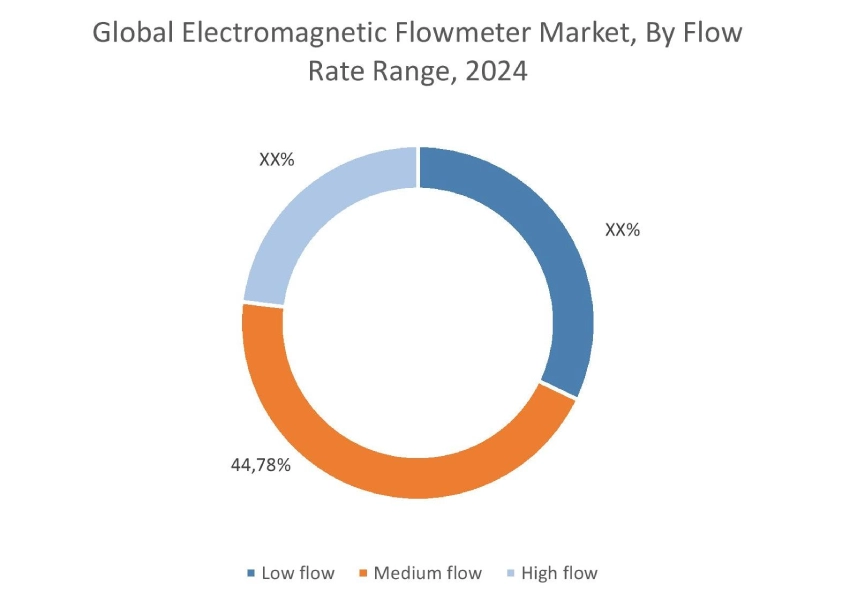
By Electrode Material:
Based on electrode material, the market is segmented into stainless steel, hastelloy, tantalum, and platinum.
Trends in the electrode material:
- Rising shift towards use 316L stainless steel for better corrosion resistance is driving the stainless steel segment, as per the electromagnetic flowmeter market trends.
- Better oxidation resistance is driving the hastelloy segment which in turn drives the electromagnetic flowmeter market share.
Stainless steel accounted for the largest revenue share in the year 2024.
- Stainless steel in magnetic flow meters have corrosion rate of less than 0.020 inches per year which helps in extending the lifespan of the electrodes.
- Stainless steel typically can withstand huge amount of stress and pressure which makes it widespread in mining and oil & gas sector, as per the electromagnetic flowmeter market analysis.
- Moreover, there has been an increasing use of sensing electrodes in magnetic flowmeters to accurately detect the induced voltage by fluids.
- For instance, Kobold offers magnetic flowmeter with IO link that features two sensing electrodes made from stainless steel for picking up the induced voltage.
- Therefore, the rising adoption of stainless steel due to better corrosion resistance and durability is driving the market during the forecast period.
Hastelloy is anticipated to register the fastest CAGR during the forecast period.
- Hastelloy offers stability at high temperatures which makes them suitable for magnetic meters used in industrial processes.
- Moreover, manufacturers have started offering electrode materials made from hastelloy B and hastelloy C due to high resistance against acids and oxidizing chemicals.
- For instance, ABB offers hastelloy B and hastelloy C electrode material for its ProcessMaster magnetic flowmeter. The resistance to corrosive liquids, acids, and bases makes the magnetic flowmeter the ideal choice for use in the chemical industry.
- Thus, the rising adoption of hastelloy B and hastelloy C for better oxidative resistance is driving the market.
By Mounting Style:
Based on the mounting style, the market is segmented into in-line, flanged, and insertion.
Trends in the mounting style:
- Increasing use of in-line magnetic flow meters for measuring conductive liquids in HVACis driving the electromagnetic flowmeter market trends.
- Factors including easy installation in existing pipelines without major excavations are driving the insertion segment.
In-line accounted for the largest revenue share in the year 2024.
- In-line magnetic meters measure the average speed of a pipe section where they are installed.
- In-line magnetic meters are integrated with other features, including bi-directional flow measurement to accurately measure the fluid rate in two opposite directions.
- Moreover, in-line magnetic flow meters come with diagnostic functions that include flow and temperature measurement.
- For instance,Kobold offers stainless steel inline magnetic flow meter with a U-PACE electronics unit that can be used for diagnostic functions including temperature measurement and bi-directional measurement.
- Therefore, the increasing use of in-line magnetic meters to measure bi-directional flow and temperature is driving the electromagnetic flowmeter market size.
Insertion is anticipated to register the fastest CAGR during the forecast period.
- Insertion magnetic flowmeters are designed for measuring flow of conductive liquids in large pipes.
- Insertion magnetic flowmeters are installed directly into pipes where it is not feasible to install a full-bore flow meter, helping in saving time and money as they can be installed without shutting down the existing systems.
- For instance, Sino-Inst offers SI-3107 insertion magnetic flow meter that can be used in large diameter pipes to measure the flow velocity of conductive liquids.
- Thus, the rising number of insertion magnetic flowmeters for easier installation in large pipes is driving the market during the forecast period.
By Output Signal:
Based on the output signal, the market is segmented into analog, digital, and modbus.
Trends in the output signal:
- Increasing adoption of analog output signals in magnetic flowmeters due to resistance to electromagnetic interference.
- There is a rising utilization of digital output in magnetic flowmeters for use in harsh industrial environments.
Analog accounted for the largest revenue share in the year 2024.
- Analog output signal converts the flow rate of a fluid into a standard voltage through a transmitter offering good stability and strong anti-interference.
- In magnetic flowmeters, the output is automatically scaled to provide 4 mA at lower range value and 20 mA at higher range scale.
- Moreover, manufacturers have started offering dual analog output in the magnetic flowmeters for better viewing of the flow rate.
- For instance, Onicon in its FT-3500 series offers dual analog output with a flow rate and energy rate.
- Therefore, the rising adoption of analog output signal due to flow rate conversion into voltage and dual output has resulted in the electromagnetic flowmeter market expansion.
Digital is anticipated to register the fastest CAGR during the forecast period.
- Digital output in magnetic flow meters helps in providing higher measurement accuracy within an error range of 0.5%.
- Moreover, companies today offer pulse output signal for different flow rates including instantaneous flow and cumulative flow rate.
- For instance, Sino-Inst offers pulse output with an upper frequency of up to 5000 CP/S in its SI-3101 magnetic flow meter. The flow meter can display accurate flow rates using digital output signal for various use cases including industrial wastewater and pulp slurry.
- Hence, the rising adoption of digital output signals due to higher measurements accuracy is driving the market.
By End User:
Based on the end user, the market is segmented into oil and gas, water and wastewater, chemical, food and beverage, power generation, mining, and others.
Trends in the end user:
- Increasing utilization of magnetic flowmeters to ensure proper intake, pump operation, and downstream treatment is driving the water and wastewater segment.
- There has been a rising trend in the adoption of magnetic flowmeters for ore slurry measurement which is driving the mining segment.
Water and wastewater accounted for the largest revenue in the overall market in 2024.
- Magnetic flowmeters are utilized in water treatment facilities to measure the volume of water that moves through the system which can help in finding leaks in the system if there is a drop in the water pressure.
- Industrial wastewater treatment plants use magnetic flowmeters to ensure clean water is released into the atmosphere by gauging how much sewage is pumped across the system.
- Moreover, manufacturers have started offering magnetic flowmeters that can operate with internal batteries.
- For instance, Toshiba offers a battery-operate magnetic flowmeter that can operate with internal batteries for 9 years.
- Thus, the rising demand for magnetic flowmeters in water and wastewater due to monitoring of leaks and battery operated flowmeters is driving the global electromagnetic flowmeter market.
Mining is anticipated to register the fastest CAGR during the forecast period.
- Mining companies use magnetic flowmeters for pulp measurements in the last phases of the production process after dewatering has taken place.
- Flow measurements for mining slurries are essential in order to fulfil the environmental protection regulations.
- Moreover, the integration of hastelloy electrode linings for less noise and extended lifetime of the flowmeter is driving the market, as per the analysis.
- For instance, Krohne offers the OPTIFLUX 4300 magnetic flowmeter that features hastelloy C4 electrodes resulting in less obstruction in the flow and therefore are less subject to wear and tear.
- Hence, the growing demand for magnetic flowmeter in mining due to accurate measurements for pulp and mining slurries has resulted in the electromagnetic flowmeter market expansion.
Regional Analysis:
The regions covered are North America, Europe, Asia Pacific, the Middle East and Africa, and Latin America.
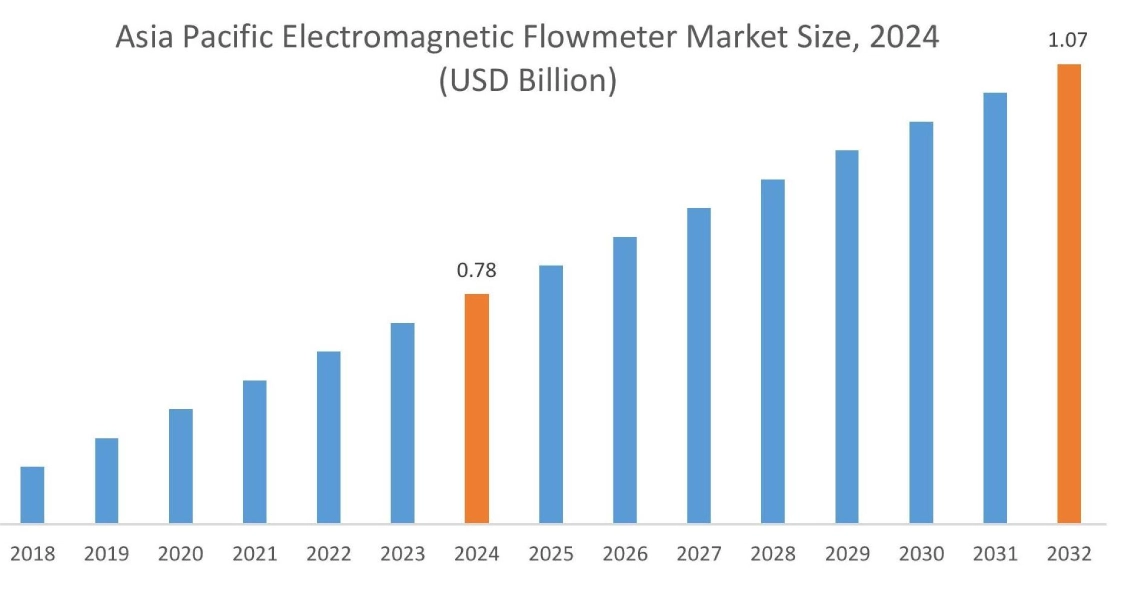
Asia Pacific region was valued at USD 0.78 Billion in 2024. Moreover, it is projected to grow by USD 0.80 Billion in 2025 and reach over USD 1.07 Billion by 2032. Out of this, China accounted for the maximum revenue of 36.22%. As per the magnetic flowmeter market analysis, the growth of magnetic flowmeters in the Asia-Pacific region is primarily driven by the rising investments in power generation and rising adoption of magnetic flowmeters in paper & pulp sector.
- For instance, in September 2022, Yokogawa announced the release of OpreX magnetic flowmeter CA series for various industries including the paper and pulp sector. The rise in adoption of magnetic flowmeters in paper & pulp sector to ensure stable measurement of fluids is expected to drive the market in Asia.
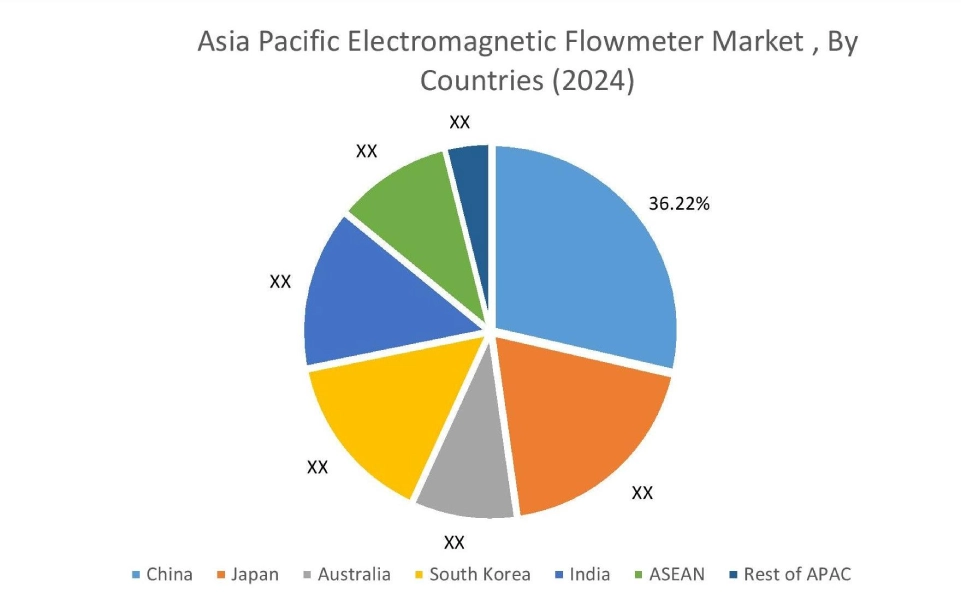
North America is estimated to reach over USD 1.09 Billion by 2032 from a value of USD 0.82 Billion in 2024 and is projected to grow by USD 0.83 Billion in 2025. In North America, the growth of electromagnetic flowmeter industry is driven by the growing investments in chemical and petrochemical sectors. Moreover, the increasing adoption of magnetic flowmeters for use in the mining sector is contributing to the electromagnetic flowmeter market demand.
- For instance, Siemens offers the SITRANS FM TRANSMAG 2 magnetic flowmeter with higher magnetic field strength than conventional magnetic flowmeters. The higher magnetic field strength makes the flowmeter ideal for heavy mining slurries, which has driven the market growth.
Additionally, the regional analysis depicts that the growth of magnetic flowmeters in oil and gas is driving the electromagnetic flowmeter industry in Europe. Furthermore, as per the market analysis, the electromagnetic flowmeter market demand in Latin America is expected to grow at a considerable rate due to growth in investments in the power generation sector. The Middle East and African region is expected to grow at a considerable rate due to factors including growing demand for magnetic flowmeters in oil and gas and rising investments in food and beverage sector, among others.
Top Key Players & Market Share Insights:
The global electromagnetic flowmeter market is highly competitive with major players providing solutions to the national and international markets. Key players are adopting several strategies in research and development (R&D), product innovation, and end-user launches to hold a strong position in the electromagnetic flowmeter market. Key players in the electromagnetic flowmeter industry include-
- Yokogawa Electric Corporation (Japan)
- Toshiba Corporation (Japan)
- Omega Engineering Inc. (U.S.)
- McCrometer Inc. (U.S.)
- Badger Meter, Inc. (U.S.)
- ABB (Switzerland)
- Siemens (Germany)
- Sino-Inst (China)
- Endress+Hauser Group Services AG (Switzerland)
- Emerson Electric Co. (U.S.)
Recent Industry Developments :
Product Launch
- In March 2024,ONICON announced the launch of the FT-3500 insertion electromagnetic flow meter and thermal energy measurement system. The flow meter features a remote transmitter with touch screen display for users to engage with the measurement values and configuration settings.
- In February 2025, TeeJet Technologies announced the launch of a new magnetic flow meter called the FM9380-F75. The flow meter contains no moving parts resulting in no service or maintenance requirements and no risk of clogging.
Electromagnetic Flowmeter Market Report Insights :
| Report Attributes | Report Details |
| Study Timeline | 2019-2032 |
| Market Size in 2032 | USD 3.49 Billion |
| CAGR (2025-2032) | 3.7% |
| By Flow Rate Range |
|
| By Electrode Material |
|
| By Mounting Style |
|
| By Output Signal |
|
| By End User |
|
| By Region |
|
| Key Players |
|
| North America | U.S. Canada Mexico |
| Europe | U.K. Germany France Spain Italy Russia Benelux Rest of Europe |
| APAC | China South Korea Japan India Australia ASEAN Rest of Asia-Pacific |
| Middle East and Africa | GCC Turkey South Africa Rest of MEA |
| LATAM | Brazil Argentina Chile Rest of LATAM |
| Report Coverage |
|
Key Questions Answered in the Report
How big is the electromagnetic flowmeter market? +
The electromagnetic flowmeter market is estimated to reach over USD 3.49 Billion by 2032 from a value of USD 2.63 Billion in 2024 and is projected to grow by USD 2.68 Billion in 2025, growing at a CAGR of 3.7% from 2025 to 2032.
Which is the fastest-growing region in the electromagnetic flowmeter market? +
Asia-Pacific region is experiencing the most rapid growth in the electromagnetic flowmeter market.
What specific segmentation details are covered in the electromagnetic flowmeter market report? +
The electromagnetic flowmeter market report includes specific segmentation details for flow rate range, electrode material, mounting style, output signal, end user, and region.
Who are the major players in the electromagnetic flowmeter market? +
The key participants in the electromagnetic flowmeter market are Yokogawa Electric Corporation (Japan), ABB (Switzerland), Siemens (Germany), Sino-Inst (China), Endress+Hauser Group Services AG (Switzerland), Emerson Electric Co. (U.S.), Badger Meter, Inc. (U.S.), Toshiba Corporation (Japan), Omega Engineering Inc. (U.S.), McCrometer Inc. (U.S.), and Others.
